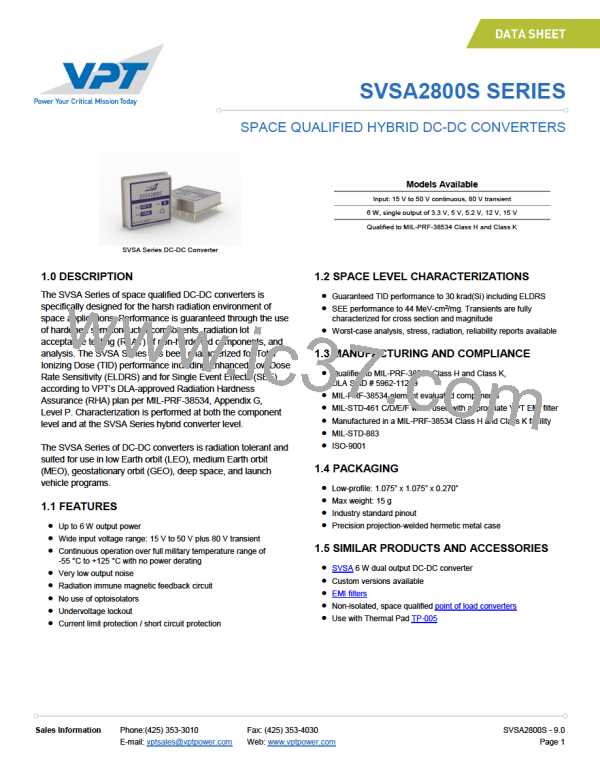SVSA2800S Series
6.5 VPT RHA PLAN AND APPROACH
VPT takes a conservative approach to radiation testing to ensure product performance during space travel. VPT’s DLA approved
Radiation Hardness Assurance (RHA) plan documents VPT’s processes and procedures for guaranteeing the performance of VPT
products under various environmental conditions in space, including TID, SEE, and ELDRS.
Documents Available
Details
The radiation environments covered by this overview include: total ionizing dose (TID), which
includes enhanced low dose rate sensitivity (ELDRS); and single event effects (SEE).
DLA approved Radiation Hardness Assurance (RHA) Plan Summary
Worst-Case Analysis Report
Stress Report
Detailed worst-case analysis guarantees circuit performance post radiation and end of life.
Individual component stress analysis and deratings are included as part of the WCA report.
An overview report on the component level RLAT and characterization testing for TID and DD
as well as the hybrid level characterizations for TID and SEE response.
Radiation Test Summary Report
Reliability Report
MTBF report based on MIL-HDBK-217 reliability calculations.
Component temperature rise analysis and measurement results.
Thermal Analysis Report
Test Definition
VPT’s Approach
Total Ionizing Dose (TID). A measure of the energy absorbed in the
semiconductor components from the naturally occurring sources of
radiation (protons, electrons, photons). This results in the slow
degradation of semiconductor performance specifications. TID is tested
by exposing components to gamma radiation from a Cobalt-60 source.
Designed for 30 krad(Si). Sensitive semiconductor components undergo RLAT to 60 krad(Si)
per MIL-STD-883 Method 1019. Converters are characterized to 60 krad(Si).
Enhanced Low Dose Rate Sensitivity (ELDRS): Many linear-bipolar
integrated circuits show enhanced parameter degradation when exposed
at low dose rates close to those seen in a space environment as
compared to the high dose rates (50-300 rad(Si)/s) that components were
traditionally tested at for TID degradation. MIL-STD-883 Method 1019
gives guidance for characterizing components for ELDRS. Components
that exhibit ELDRS are tested for TID at a rate below 0.01 rad(Si)/s.
All bipolar linear ICs are characterized for ELDRS sensitivity and tested in accordance with
MIL-STD-883 test method 1019 section 3.13
Single Event Effects (SEE). Single high energy protons and heavy ions
can deposit sufficient energy in a semiconductor component, causing a
range of effects. SEEs include single event latchups (SELs), single event
gate ruptures (SEGRs), single event transients (SETs), single event
functional interrupts (SEFIs) and single event burnouts (SEBs).
Converters are characterized for catastrophic events (SEL, SEB, SEGR) as well as functional
interrupts (SEFI) under heavy ion exposure to LET = 44 MeV-cm2/mg. Converters are also
characterized for cross section and magnitude of output transients (SET) for at least 3
different LET levels.
Radiation Lot Acceptance Testing (RLAT): Semiconductor wafer lots are
exposed to TID on a sample basis. If the parameter degradation for the
tested samples is within the predetermined acceptance limits, then the lot
can be used in radiation hardened converters.
Sensitive semiconductor components undergo RLAT for TID.
Sales Information
Phone:(425) 353-3010
Fax: (425) 353-4030
Web: www.vptpower.com
SVSA2800S - 9.0
Page 10
E-mail: vptsales@vptpower.com

 VPT [ VPT, Inc. ]
VPT [ VPT, Inc. ]